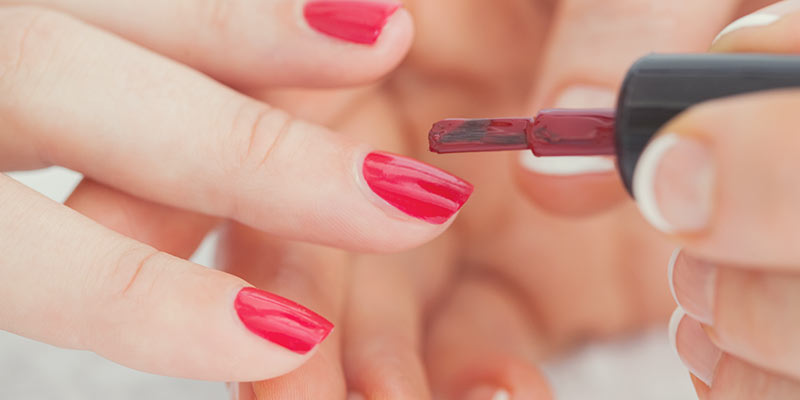How harmful are the chemicals in your average nail polish?
Many believe that because nail polish is widely available on store shelves and have no warning label, it is free of health risks. Sadly this is not the case.
Although nail polish brands in Australia are required to disclose product ingredients, they don’t have to warn you about the health concerns associated with those ingredients.
Chemicals in nail polish can be harmful to everyone who uses them, especially those who are exposed repeatedly such as beauticians and people who frequently have their nails done. To keep yourself and those around you safe, choose polishes that avoid the “toxic trio” – Formaldehyde, Toluene and Dibutyl Phthalate (DBP) and some additional nasties like synthetic Camphor, Formaldehyde Resin, Xylene and Tosylamide.
Note: These toxins should also be avoided by women who are pregnant or nursing, as well as children who have not yet passed puberty.
The toxic nasties found in most Nail Polishes
Formaldehyde
Formaldehyde is used to harden and strengthen nail polishes, also serving as a preservative that protects against bacterial growth.
Nail salon workers and their children are especially at risk for chronic health problems caused by formaldehyde, including asthma, convulsions, nausea, and miscarriages. Studies have suggested that formaldehyde exposure may also be associated with certain types of cancer.
The International Agency for Research on Cancer classifies formaldehyde as a known human carcinogen.
Toluene
Toluene helps keep the polish from becoming too watery while you’re painting it on, and makes it dry to a hard and shiny finish.
Produced primarily from coal tar & petroleum, Toluene is a moderate skin irritant that can cause dermatitis with prolonged contact. It is also a developmental toxicity hazard and has been identified in human milk. Inhalation of toluene vapour can affect the central nervous system causing slight drowsiness and headache at low levels and Irritation of the nose, throat and respiratory tract at increased levels.
The EU has restricted the use of toluene and advises that pregnant women and children should not be exposed to its fumes.
DBP (Dibutyl Phthalate)
The chemical Dibutyl Phthalate (DBP) acts as a binder to prevent nail polishes from becoming brittle and minimises chipping.
However it’s also been linked to cancer in lab animals, and underdeveloped genitals and other long-term fertility problems in newborn boys. This phthalate is classified by the European Union as a suspected endocrine disruptor and toxic to reproduction, strongly suspected of causing cancer, mutations or birth defects.
The EU has completely banned DBP.
Synthetic Camphor
Synthetic Camphor is the ingredient used to give nail polishes their glossy, shiny appearance.
It is less toxic than the ingredients listed above, however the safety of camphor has recently been called into question. It has been shown to trigger severe skin irritation and allergic reactions when applied topically, and inhaling its fumes can cause nausea, dizziness, and headaches.
The European Union have begun to phase out camphor due to safety concerns.
Formaldehyde Resin
Formaldehyde Resin is a by-product of formaldehyde used to give nail polishes and tough, shiny and durable finish.
Preliminary studies show that can cause severe skin irritation, allergic reactions and skin depigmentation. Because formaldehyde resins are used in many household materials it is one of the more common indoor air pollutants. Inhaled formaldehyde may cause headaches, a burning sensation in the throat, and difficulty breathing, and can trigger or aggravate asthma symptoms.
The European Union allows only limited use of formaldehyde in personal care products, while Japan and Sweden have banned it completely.
Xytol
Xytol (or listed as dimethylbenzene) is used as a solvent in nail polish.
Xytol can irritate the skin and respiratory tract and may cause liver damage in high concentrations.
Tosylamide
Tosylamide (commonly mixed with Formaldehyde Resin) is a soft resin material which forms tough, shiny and durable film on nails while maintaining a high gloss.
Studies show strong evidence that Tosylamide can instigate an immune system response that can include itching, burning, scaling, hives, and blistering of skin.
Sienna Eco-Nail Polish
If you are looking to avoid the nasty ingredients above you are going to love Sienna polishes.
Sienna Nail Polishes are committed to creating a healthier formula, for you, and your loved ones. They have the cleanest conventional formula on the market, none of the toxic trio and quite a few others taken out too!
Everything they do is aimed towards creating a cleaner alternative. Not just as a product but as an overall lifestyle. They’re as local as can be, vegan & cruelty free, use 100% renewable soy and source sustainable non-native timbers from our own backyard.
We also trialed these polishes for 2 months before deciding it was the right fit for our stores. It is durable and long lasting which is very important in the professional services we provide and for our customers needs.
For more information visit our Sienna Eco-Polishes page.



